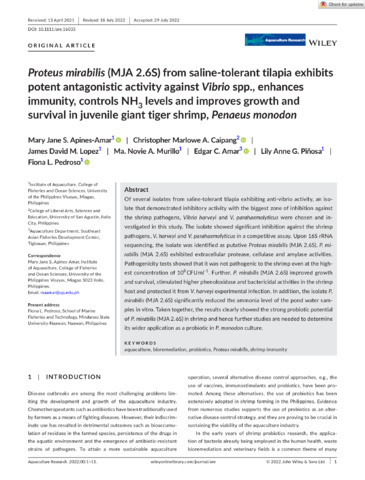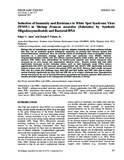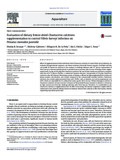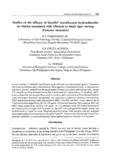Proteus mirabilis (MJA 2.6S) from saline-tolerant tilapia exhibits potent antagonistic activity against Vibrio spp., enhances immunity, controls \(\mathsf{NH_3}\) levels and improves growth and survival in juvenile giant tiger shrimp, Penaeus monodon

View/
Date
2022-08-10Author
Page views
690Metadata
Show full item recordCited times in Scopus
Share
Abstract
Of several isolates from saline-tolerant tilapia exhibiting anti-vibrio activity, an isolate that demonstrated inhibitory activity with the biggest zone of inhibition against the shrimp pathogens, Vibrio harveyi and V. parahaemolyticus were chosen and investigated in this study. The isolate showed significant inhibition against the shrimp pathogens, V. harveyi and V. parahaemolyticus in a competitive assay. Upon 16S rRNA sequencing, the isolate was identified as putative Proteus mirabilis (MJA 2.6S). P. mirabilis (MJA 2.6S) exhibited extracellular protease, cellulase and amylase activities. Pathogenicity tests showed that it was not pathogenic to the shrimp even at the highest concentration of 108 CFU ml−1. Further, P. mirabilis (MJA 2.6S) improved growth and survival, stimulated higher phenoloxidase and bactericidal activities in the shrimp host and protected it from V. harveyi experimental infection. In addition, the isolate P. mirabilis (MJA 2.6S) significantly reduced the ammonia level of the pond water samples in vitro. Taken together, the results clearly showed the strong probiotic potential of P. mirabilis (MJA 2.6S) in shrimp and hence further studies are needed to determine its wider application as a probiotic in P. monodon culture.
Description
Online Version of Record before inclusion in an issue.
Keywords
aquaculture bioremediation probiotics Proteus mirabilis shrimp immunity Phenoloxidase proteaseSuggested Citation
Apines-Amar, M. J., Caipang, C. M., Lopez, J. D. M., Murillo, M. N. A., Amar, E., Piñosa, L. A. G., & Pedroso, F. (2022). Proteus mirabilis (MJA 2.6S) from saline-tolerant tilapia exhibits potent antagonistic activity against Vibrio spp., enhances immunity, controls \(\mathsf{NH_3}\) levels and improves growth and survival in juvenile giant tiger shrimp, Penaeus monodon. Aquaculture Research , 53(16), 5510-5520. https://doi.org/10.1111/are.16033
Subject
Taxonomic term
Collections
- AQD Journal Articles [1249]
Related items
Showing items related by title, author, creator and subject.
-
Induction of immunity and resistance to white spot syndrome virus (WSSV) in shrimp Penaeus monodon (Fabricius) by synthetic oligodeoxynucleotide and bacterial DNA
Amar, Edgar C.; Faisan, Joseph P., Jr. (University of the Philippines Los Baños, 2012)Shrimps like all invertebrates are believed to lack true adaptive immunity but recent evidence indicate that they can be protected against pathogenic organisms by priming their immune system with immunostimulatory substances. ... -
Evaluation of dietary freeze-dried Chaetoceros calcitrans supplementation to control Vibrio harveyi infection on Penaeus monodon juvenile
Seraspe, Ebonia B.; Gabotero, Shirleny; de la Peña, Milagros R.; Pahila, Ida G.; Amar, Edgar (Elsevier, 2014)Effects of supplementation of diets with freeze-dried Chaetoceros calcitrans to control Vibrio harveyi infection are evaluated through immune responses, and disease resistance of juvenile Penaeus monodon. Total lipid and ... -
Studies on the efficacy of Sarafin® (sarafloxacin hydrochloride) on vibrios associated with vibriosis in black tiger shrimp (Penaeus monodon)
Pakingking, Rolando V., Jr.; Lacierda, Erlinda; Torres, James L. (Fish Health Section, Asian Fisheries Society, 2002)In vitro activity of Sarafin® (sarafloxacin hydrochloride) was determined against 7 luminous Vibrio harveyi isolates and 3 non-luminous Vibrio species (V. parahaemolyticus, V. alginolyticus and Vibrio species) isolated ...



